Best Sheep Breeds for Meat
Are you interested in raising sheep for meat? The American Sheep Industry recognizes 47 different sheep breeds in the US, with hundreds more recognized internationally. How do you decide which breed is right for your needs?
What sheep breeds are best for meat? There are many great options for meat-producing sheep. Here is a list of the top 10 sheep breeds for meat:
- Suffolk Sheep
- Dorper Sheep
- Dorset Sheep
- Katahdin
- Icelandic Sheep
- Barbados Blackbelly
- Hampshire Sheep
- Texel Sheep
- Tunis Sheep
- Cheviot Sheep
Sheep are one of the most versatile livestock animals you can find when it comes to the number of different products they are able to produce. While mutton and lamb may seem like more of a rarity in America, it is more popular as a main dish in other parts of the world. Whether you’re looking to be more self-sufficient or to make some income selling meat to local restaurants, raising sheep for meat can enable you to do both. Keep reading to learn more about the best sheep breeds for meat.
Best Sheep Breeds For Meat: Suffolk Sheep
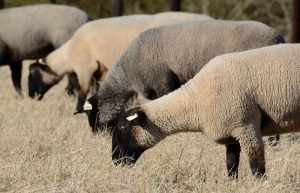
As one of the most populous sheep breeds in America, the Suffolk is a popular choice for meat producers. Suffolk ewes reach between 180-250 pounds, while rams can top out at 350 pounds. Reaching maturity earlier than many breeds, the Suffolk lamb will reach an average of 116 pounds by 100 days of age. Most lambs are considered market-ready by 9-12 weeks.
Suffolk ewes are excellent mothers and prolific breeders. Mating season for Suffolk sheep usually happens in the Autumn or Winter of each year, as it is for most sheep breeds. Suffolk ewes have an excellent lambing rate of 180%, making them a solid choice for breeding.
Suffolk meat is hailed as lean and somewhat sweet, with a good muscle to fat ratio. This breed tolerates both heat and cold – making them a good choice for most climates. Suffolk grow wool continuously, and will need to be sheared annually.
Best Sheep Breeds For Meat: Dorper Sheep
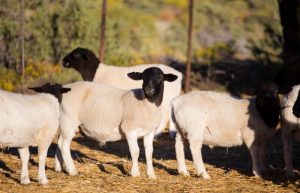
The Dorper sheep has gained popularity in the last decade for meat production, with ewes reaching a weight of 170-250 pounds, and rams up to 250 pounds. Dorpers are well-known to mature early as well, with most lambs considered market-ready in as little as 4 months old.
A unique characteristic about the Dorper is that they do not breed seasonally, instead they are able to breed year-around. This means that, theoretically, a Dorper ewe can produce a lamb (or 2 or 3) every 8 months.
Dorper sheep do well in warm, arid climates, but can tolerate cold as well. Dorpers grow a combination of hair and wool, and shed naturally – meaning no shearing is required. Because of their hair, they do not produce the lanolin that can lend gaminess to the meat, giving it a milder flavor.
Best Sheep Breeds For Meat: Dorset Sheep
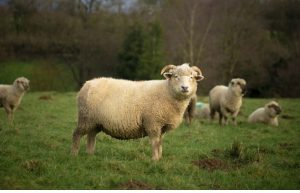
Considered to be the 2nd most popular breed of sheep in the US, the Dorset sheep is another solid meat-producer. Dorset ewes weigh approximately 150-200 pounds, with the rams weighing on average 275 pounds. Dorset lambs, like the Suffolk and Dorper, mature quickly and are market-ready earlier than many other breeds.
Like the Dorper, Dorset ewes are able to breed year-round and are not limited to a typical Fall/Winter breeding season. Dorsets commonly produce twins and even triplets.
Dorset sheep have lean and muscular carcasses, making them excellent at producing meat. Dorset sheep thrive in a wide variety of climates, and being wool-producers, they will need to be sheared annually.
Interested in raising sheep for wool? Check out my article Best Sheep for Wool: Top 8 Sheep Breeds for Wool.
Best Sheep Breeds For Meat: Katahdin Sheep
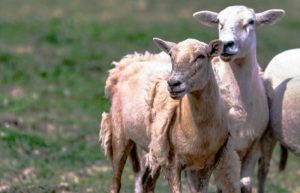
Katahdins are a popular meat breed for sheep farmers. Katahdin ewes weigh around 125-185 pounds, and rams average around 200 pounds. They grow quickly and reach market weight early.
Katahdins often breeding out of season. Katahdins tend to birth twins, with triplets and quadruplets occurring often with good flock management. Katahdins are alert, protective mothers. They reach sexual maturity early, and will remain fertile for a longer period of time than many other breeds.
Katahdin meat tends to be leaner than many other breeds. Katahdins have hair and not wool, which means they are a low-maintenance breed that will shed their hair naturally. Because of their hair, like the Dorper they do not produce lanolin which will give their meat a milder taste. This breed is adaptable and can live in many different climates.
Best Sheep Breeds For Meat: Icelandic Sheep
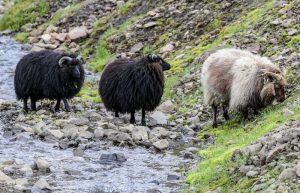
Icelandic Sheep are another popular choice for meat, with ewes weighing an average of 150 pounds at maturity, and rams averaging 200 pounds. Vigorous growers, the Icelandic produce lambs that are market-ready at 70-100 pounds in as little as 4-5 months.
Icelandic Sheep are excellent and reliable breeders, breeding seasonally in the Fall to Winter. They reach sexual maturity very early, with ewes able to breed between 7 to 9 months of age.
Being native to Iceland, this breed is exceptionally cold-hardy, and is an excellent and efficient forager – making it able to thrive and find food in harsh environments. Due to the high amount of red muscle fibers, the Icelandic sheep has a uniquely tender and fine texture. Though the breed produces wool (and lanolin), it is known to have a particularly mild taste. Because of the wool, the Icelandic sheep do need to be sheared once to twice per year.
Best Sheep Breeds For Meat: Barbados Blackbelly
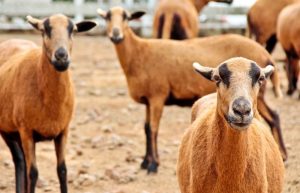
The Barbados Blackbelly got its name because of the characteristic black belly on an otherwise red brown coat. The Blackbelly is a smaller breed of sheep, with ewes maturing at around 100 pounds, and rams weighing on average 120 pounds. In addition to being a smaller breed, the lambs tend to mature slowly, not reaching ideal market weight until around 2 years of age. Though size and time to mature are not the Blackbelly’s strongest points, there are many advantages to raising this hardy breed of sheep.
Blackbellys often breed easily and well, usually birthing multiple lambs in one breeding. They also are not limited to a breeding season, conceiving year round.
Blackbelly’s have hair and not wool, making them a low-maintenance breed. They are also highly resistant to many parasites that can become bothersome to other breeds of sheep. Blackbelly’s are often left unvaccinated due to their disease and parasite resistance (though of course, we recommend you do your research on the breed and talk to a vet about what they recommend for vaccinating). Because of their hair and their low fat content, this breed is known to produce both flavorful and mild meat.
This breed is also exceptionally hardy, able to thrive in both the cold, and the hot, humid climates in which many farmers struggle to raise sheep, making it a good choice for almost any climate in the United States.
Best Sheep Breeds For Meat: Hampshire Sheep
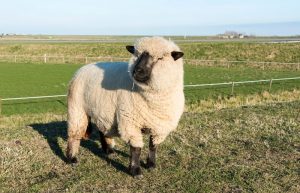
Hampshire sheep have a muscular and stocky build, and are comparative to the Suffolk in size. Ewes weight approximately 200 pounds, and rams average out to around 260 pounds. Though large in size, Hampshire sheep tend to be a docile and easy-going breed. This breed produces rapid-growing lambs, with most lambs being considered ready for market at 12 weeks of age.
While Hampshire sheep are seasonal breeders, they tend to have a longer breeding season than others. They are prolific breeders as well, often producing twins.
Hampshire sheep can live in almost any climate, making them a hardy breed. They do produce wool, and will need to be shorn annually. Bred to produce less back fat, their meat is lean and flavorful.
Best Sheep Breeds For Meat: Texel Sheep
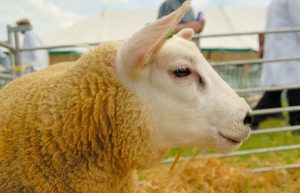
The bodybuilder of the sheep world, the Texel sheep is known for its heavily-muscled and sturdy frame. Ewes will weigh an average of 190 pounds, with rams reaching up to 300 pounds. Like most of the sheep listed here, Texel lambs reach market size quickly, by 5-6 months.
With an extended breeding season of nearly 5 months, Texel sheep are prolific breeders. Ewes typically reach sexual maturity by 7 months.
Texel sheep do best in colder climates, as they are exceptionally cold-hardy and have been known to be sensitive to the heat. They do produce wool, and will need regular shearing. Due to its heavily muscled carcass, the Texel sheep is a very popular meat breed.
Best Sheep Breeds For Meat: Tunis Sheep
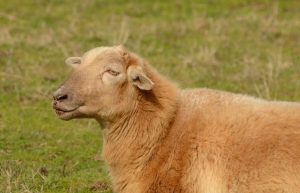
One of the oldest breeds of sheep, the Tunis is still a favorite breed for meat production. This breed averages in maturity at around 175 – 220 pounds. Lambs are efficient producers of meat.
Though not year-round breeders, Tunis often breed out of season, with the occasional lamb (or two) born in late Summer / Fall. Tunis are solid breeders and excellent mothers.
Tunis sheep are able to thrive in a variety of climates, and tolerate both heat and cold well. They do produce wool, and will need to be shorn annually. Tunis sheep are known to have an excellent flavor of meat.
Best Sheep Breeds For Meat: Cheviot Sheep
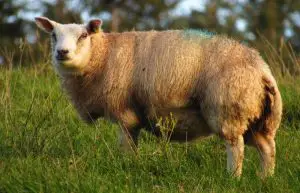
Last but not least on our list is the Cheviot breed. Average weight for the Cheviot is 130 – 175 pounds. Cheviots produce alert, strong lambs who are efficient foragers.
Cheviots are easy to breed, meeting a 90% lambing average without assistance. They are seasonal breeders, conceiving in the Fall and Winter.
The Cheviot sheep is best suited for northern, colder climates, and does not tolerate heat as well. They do produce wool, and need to be shorn on a regular basis. The carcass of the Cheviot tends to be plump and meaty, with just enough fat to produce a succulent meat.
What to Look for When Researching Sheep Breeds for Meat
There are a few characteristics you will want to look for when choosing a meat-producing sheep. Any sheep can technically produce meat, but if you’re looking to raise sheep for commercial meat production, you’ll want to make sure you get a good return on investment.
You will want to take into account the mature size of the animal (you can expect to yield 40% of an animal’s live weight in meat), the quality of meat, and whether it will tolerate your climate. If breeding your own sheep for sustainable meat production, you will also want to know the breeding habits of each breed, and whether the sheep produces wool or grows hair – this is helpful to know when it comes to maintenance.
The Difference Between Mutton and Lamb
If you plan on going into the meat production business, it’s important to know the difference between types of sheep meat. The phrases you’ll hear most often is either mutton or lamb. Mutton is meat that comes from mature sheep over the age of 1 year old. Lamb comes from a sheep under the age of 1 year old. Lamb meat is known to be more tender and tasty.
If you plan on raising lambs for meat, you’ll need to know everything that comes with taking care of baby sheep. To learn more about baby sheep, check out my article Baby Sheep: What a Baby Sheep is Called & Other Fun Facts.
Sheep are one of the most versatile producers when it comes to livestock animals. To learn more about how you can make money off of sheep, read my article What Do Sheep Produce? Ultimate Guide.
